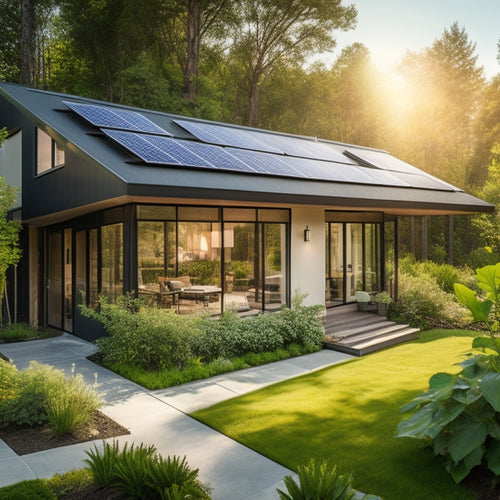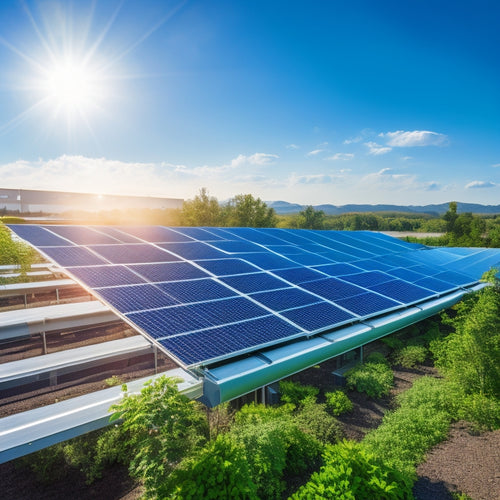
Top 3 Least Expensive Solar Panels for Homes
Share
When searching for the top 3 least expensive solar panels for homes, you'll find options like ReneSola's 270W polycrystalline panel with an efficiency rate of 17.2% at a competitive price, Trina Solar's 260W monocrystalline panel with a higher efficiency rate of 19.3%, and other budget-friendly options. Keep in mind that cheaper panels often compromise on efficiency, affecting energy output. You'll need to weigh upfront costs against long-term benefits, including energy savings and government incentives like the Solar Investment Tax Credit. As you weigh your options, consider the factors that'll impact your overall savings in the years to come.
Key Takeaways
- ReneSola 270W polycrystalline panel offers a competitive price with an efficiency rate of 17.2%.
- Trina Solar 260W monocrystalline panel provides a higher efficiency rate of 19.3% at a slightly higher cost.
- Lower-priced panels often come with reduced efficiency, affecting overall energy output and long-term savings.
- Government incentives like the Solar Investment Tax Credit (ITC) can help offset the upfront costs of solar panels.
- Balance upfront costs with long-term benefits, including energy savings and potential increase in property value.
Most Affordable Solar Panel Brands
Investigate the market for affordable solar panel brands, and you'll find a mix of established players and emerging companies vying for your attention.
When evaluating these brands, take into account factors beyond upfront cost, such as energy efficiency, warranty, and customer support. Look for brands that offer cost-effective solutions without compromising on performance.
Several brands stand out for their commitment to energy efficiency and affordability. Companies like Trina Solar and Jinko Solar offer high-efficiency modules at competitive prices.
Other brands, such as Hanwha Q CELLS and LONGi Solar, prioritize research and development to improve energy output while keeping costs low.
While it's important to reflect on the initial investment, it's equally important to think about long-term savings. A more efficient system may cost slightly more upfront but can lead to greater energy savings over time.
As you weigh your options, prioritize brands that balance affordability with performance and energy efficiency. By doing so, you'll find a cost-effective solution that meets your energy needs without breaking the bank.
Budget-Friendly Solar Panel Options
When you've identified a reliable brand, it's time to examine specific solar panel options that fit your budget.
You'll want to take into account factors like energy efficiency, which affects how much power your panels produce per hour of sunlight. Look for panels with high efficiency ratings (measured in watts per square foot) to maximize your energy output.
Another vital factor is installation costs. While high-efficiency panels may be more expensive upfront, they can lead to long-term savings by reducing the number of panels needed for your system.
Be sure to include the cost per watt, as well as any additional features like inverters or mounting hardware.
Some budget-friendly options to investigate include monocrystalline silicon panels, which offer a good balance of efficiency and affordability.
You may also take into account polycrystalline silicon panels, which are often cheaper but slightly less efficient.
Cheapest Solar Panels for Homes
Operating on a tight budget, you're likely looking for the cheapest solar panels for homes that still deliver reliable performance. While cost is a significant factor, it's crucial to evaluate solar panel efficiency as well. Lower-priced options often have lower efficiencies, which may impact your overall energy output.
However, some brands offer affordable options with decent efficiencies. For instance, the ReneSola 270W polycrystalline solar panel has an efficiency rate of 17.2% and is priced competitively. Another option is the Trina Solar 260W monocrystalline solar panel, which boasts an efficiency rate of 19.3%.
Both of these options are eligible for government incentives, such as the Solar Investment Tax Credit (ITC), which can help offset the upfront cost.
When evaluating the cheapest solar panels for homes, be sure to weigh the upfront cost against the long-term benefits, including energy savings and potential incentives. By doing so, you can make an informed decision that meets your energy needs and budget constraints.
Frequently Asked Questions
Can I Install Solar Panels Myself to Save Money?
You can attempt a DIY installation to cut costs, but beware: improper mounting and electrical connections can lead to safety hazards, reduced efficiency, and voided warranties, making long-term Solar panel maintenance a significant concern.
Do Solar Panels Work Well in Areas With Partial Shade?
You're likely aware that 22% of rooftop solar installations are affected by shade, but did you know that solar panels can still generate 50-75% of their maximum power in partially shaded areas? Your solar panel performance will degrade, but modern panels' shade tolerance helps mitigate the impact.
How Long Does It Take to Pay off a Solar Panel System?
You'll break even on your solar panel investment in 5-7 years, depending on energy cost reduction and solar panel savings, which can reach up to $500 annually, offsetting the initial system cost.
Are There Any Government Incentives for Solar Panels?
You'll be thrilled to know that in 2020, over 2 million solar installations were completed in the US alone! Now, regarding government incentives, you're eligible for federal tax incentives, covering up to 26% of your system's cost, plus state rebate programs that vary by location.
Do Solar Panels Increase My Home's Value?
You'll enhance your home's value by installing solar panels, as they're considered a desirable upgrade, adding appeal to potential buyers, and increasing your home appraisal, thanks to the solar panel benefits of reduced energy bills and environmental benefits.
Conclusion
You've made it to the end of our solar panel cost-cutting expedition, only to realize that the cheapest options might not be the best bang for your buck. Ironically, investing in higher-quality panels might actually save you more in the long run. But if budget constraints are a hard limit, our top 3 picks should get you started. Just remember, you get what you pay for - and in this case, it's a few watts of power and a whole lot of hope.
Related Posts
-

Solar Power for Reducing Carbon Footprint
Solar power is an effective strategy for reducing your carbon footprint. By adopting solar energy, you can cut greenh...
-

Integrating Solar Panels Into Home Design
Integrating solar panels into your home design greatly enhances energy efficiency and lowers utility bills while addi...
-

Solar Energy Efficiency Improvements for Businesses
Improving solar energy efficiency for your business can lead to considerable cost savings and enhance your sustainabi...


